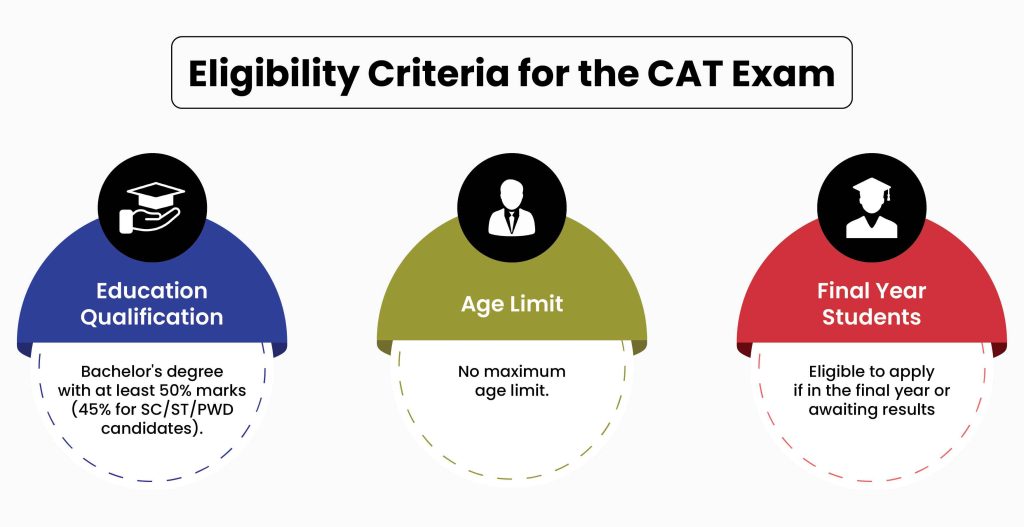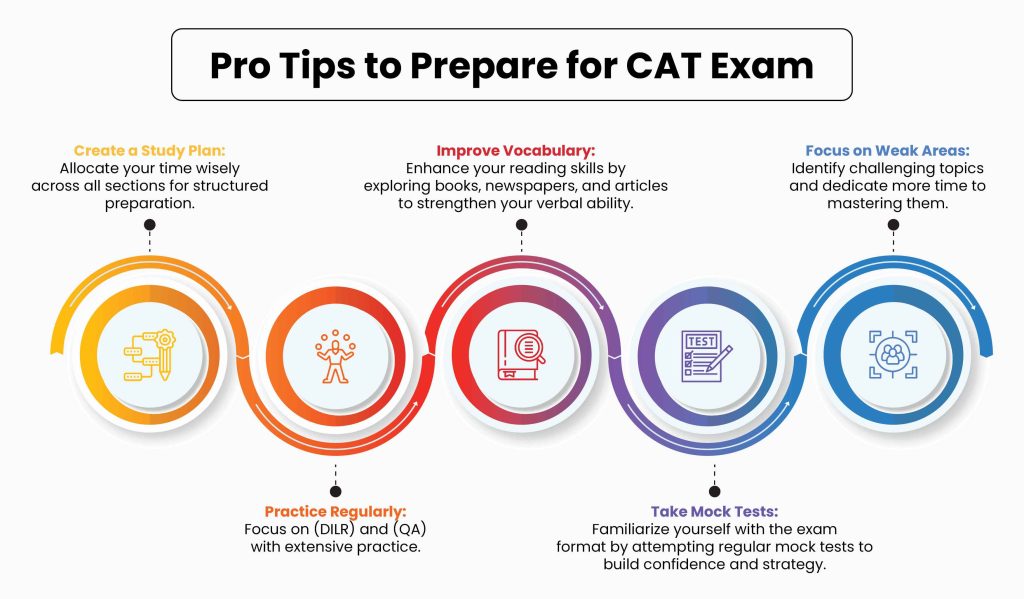Are you interested in pursuing an MBA from one of the top Indian institutions such as the IIMs? The CAT exam is the key to success! The CAT exam is among the most crucial tests exam, and our thorough guide explains the CAT syllabus for the MBA. The test is broken down into three parts: Verbal Ability and Reading Comprehension (VARC), Data Interpretation and Logical Reasoning (DILR) and Quantitative ability (QA). It is crucial to pass the test.
This blog will clarify any confusion you have about the CAT exam the syllabus, pattern and eligibility. Create a successful study plan and increase your confidence for this exam that is highly competitive!
Understanding the CAT Exam
The Common Admission Test, or CAT is one of the most important management entrance tests that are used to choose candidates for Master of Business Administration or MBA programs in India. It is a different national MBA entrance exam conducted in conjunction with IIMs. IIMs every year. It can be regarded as one of the most competitive and popular tests.
It is essential to study and comprehend all aspects of the CAT syllabus to be able to pass an MBA for an easy time preparing and a high chance of success in the examination stage.
It covers a variety of marketing aspects including market research as well as branding management, social psychology marketing campaigns, advertising marketing and strategic management of marketing. Students are instructed in designing and implementing effective marketing strategies that focus on attracting people, retaining them, and expanding the value of brands and profits for companies.
Exam Pattern for the CAT Syllabus
Here’s an overview of the exam format for the CAT syllabus:
Aspect | Details |
Number of Questions | 100 questions, evenly distributed across three parts |
Timing | 60 minutes for each section, for a total of 180 minutes (3 hours) |
Question Types | MCQs and non-MCQs |
MCQ Scoring | Correct Answer : 3 Marks Each Incorrect Answer: 1 Mark for Each |
Non-MCQ Scoring | There is no penalty for incorrect answers. Students simply type their answers |
Scoring System | Based on both negative and positive scores Positive marks are awarded in accordance with the proficiency level. |
Understanding the CAT Exam Syllabus for MBA
The syllabus for the CAT exam is broken down into three major sections:
- Verbal Ability and Reading Comprehension (VARC)
- Data Interpretation and Logical Reasoning (DILR)
- Quantitative Ability (QA)
The sections test different abilities and specific areas of expertise. The sections are equally crucial. This is why it is essential to study thoroughly each section of CAT exam syllabus to prepare for MBA.
Verbal Ability and Reading Comprehension (VARC)
This section is a test of your English proficiency. This section of the CAT outline for the MBA contains questions about vocabulary, grammar, and comprehension of reading. The objective is to test your ability to comprehend and utilize English effectively.
Topics Covered in VARC:
- Reading Comprehension Reading Comprehension: The passages are and questions.
- Grammar: Sentence Correction and Usage.
- Vocabulary: Synonyms, Antonyms, Word Usage.
- The Verbal Reasoning Test: Paragraph complete and Para-Jumbles.
Data Interpretation and Logical Reasoning (DILR)
The section includes questions that you can answer by analysing logically and organizing the data. Certain questions test your ability to comprehend data and information and to interpret questions logically. This section of the CAT syllabus for the MBA isn’t easy which is why regular practice is vital.
Topics Covered in QA:
- Arithmetic: Percentages, Ratios simple and compound interest.
- Algebra: Equations, functions, progressions.
- Geometry: Lines, angles, triangles, circles.
- Number System: Whole numbers, ints and fractions.
- Modern Math: Probability, permutations, and combinations.
Quantitative Ability (QA)
It is the QA part is the mathematical section that was designed to test your mathematics ability. It is comprised of questions that fall under algebra, arithmetic and geometry categories, or sections.
This section of the CAT syllabus for the exam for MBA is vital as it evaluates your ability to solve problems using equations and numbers, as well as techniques for managing time.
Topics Covered in QA:
- Arithmetic: Percentages, Ratios compound and simple interest.
- Algebra: Equations, functions, progressions.
- Geometry: Lines, angles, triangles, circles.
- Number System Number System: Whole numbers, integers and fractions.
- Modern Math: Probability, combinations, permutations.
CAT Exam Syllabus for MBA
To make it easier for you to grasp, here’s an extensive table that summarizes the syllabus for CAT exams.
Section | Topics | Description |
VARC | Reading Comprehension | Questions and answers to passages |
| Grammar | Correction of sentence Use |
| Vocabulary | Synonyms Word usage, antonyms |
| Verbal Reasoning | Paragraph completion, para-jumbles |
DILR | Data Interpretation | Tables, charts, graphs |
| Logical Reasoning | Puzzles or seating arrangements Blood relations, puzzles |
| Data Sufficiency | Analysing data sufficiency |
QA | Arithmetic | Percentages, ratios, interest calculations |
| Algebra | Functions, equations, progressions |
| Geometry | Lines, angles, triangles, circles |
| Number System | Whole numbers, fractions, integers |
| Modern Math | Probability, permutations and combinations |
Eligibility for the CAT Exam

To be able to sit for the CAT examination Candidates must satisfy the requirements listed below:
Academic Qualification: The absolute requirement to be eligible for the CAT exam is an undergraduate degree, with at 50 percent marks, or a similar CGPA attained (45 percent in the SC, ST, and PWD categories).
Age Limits: The CAT test is open to everyone regardless of age with no age limit.
Students in the Final Year Can take part in CAT when they are in their final semester of the Bachelor’s or equivalent exam or finished their bachelor’s degrees, and are waiting their results.
CAT Exam Month: Key Details
It is a common test which is conducted once per year by students who are hoping to be admitted to a top B-school like IIM. The test is typically held during the final month of November. The date for writing the CAT is clearly declared by the coordinating IIM typically in the month of August or September. Therefore, it is recommended to periodically look over the information available on the official CAT website for all the necessary information.
With the close of academic term nearing many students are looking towards the CAT exam.
To some students the curriculum used to the CAT MBA online exam is very well-understood. According to the saying “failure to plan; be prepared to fail’ is said the same way, preparation is crucial in the activities that will be conducted in the near future.
Pro Tips to Prepare for the CAT Exam

- Make a Study Plan: For the test you must spread your time between 50 and 25 % for section one and 25 percent for section two while 25% is for section three. It is important to have a timely and balanced time distribution for each part of the CAT syllabus is required to be successful in an MBA.
- Make Time to Practice: DILR and QA require regular practice as it can make it easier to manage the two in any scenario. The easiest method for doing this is to begin with an example paper from the specific syllabus and then look through the question papers from previous years.
- Enhance Your Vocabulary: In order to improve your English abilities and language skills, and to comprehend written English Read as many books, papers and other articles as you can. This will aid students when you are in studying the Logical Reasoning section and also in the VARC section.
- Try Mock tests: Mock tests certainly have their advantages, the primary benefit comes from the fact that they can help you get used to the format of the test, making it simpler to manage your time and efforts in solving the problems.
- Focus on Weak Areas: The third thing to do is know which specific skills/subjects/activities you are not good at, then practice those particular things. Spend more time on subjects or lessons you’ve deliberately or accidentally left behind in an effort to get as much knowledge as feasible in the shortest amount of time.
- Time Management: Hence it is essential that the time for preparation be managed effectively to learn the material that the MBA CAT exam covers. Every section is given a time limit, so you must learn how you can manage the allocated time effectively.
Resources for Preparation
There are numerous sources to help get ready for the CAT MBA exam. MBA:
- Books: A few books are available for sale that contain the syllabus of the MBA CAT test. Some of them include “Quantum Leap for CAT–A Guide to Tackle Any Quantitative Aptitude for CAT” and “Word Power Made Easy” written by Norman Lewis.
- Online Courses: Many websites and blogs offer online classes and self-study materials that cover the syllabus needed to take the CAT exam for MBA.
- Coaching Centres: If want to join the class, many coaching centers offer courses to help you prepare.
Conclusion
With the assistance of the mentioned elements, one can prepare and finish the CAT syllabus for MBA. It is crucial to keep in mind that no exam can be a challenge, and the process of the preparation for any exam will require a constant and determined effort. A MBA hopeful must read the entire outline for the CAT exam, and review each section, practicing lots.
Hike Education wishes all the MBA candidates the best of luck in the test.
The two options you have to pick from must be relevant to your passions, skills and career goals. By putting together branding strategies and marketing campaigns you can encourage behavioural shifts among consumers or opt to work in the realm that is based on numbers as well as finance(s) and which, in turn, will lead to an enviable career.
Frequently Asked Questions
The syllabus for the CAT exam for MBA includes three major areas: Verbal and Reading Comprehension (VARC), Data Interpretation and Logical Analysis (DILR) and Mathematical Skills (Quant)
These suggestions will aid in improving your VARC score Learn to read books, newspapers and other articles as frequently as you can to increase your vocabulary and improve your comprehension. Training your grammar skills and the verbal reasoning portion of the test is important.
The subject typically covers subjects like arithmetic, geometry, algebra and measurement systems, as well as modern math that include permutations, probabilities and combinations.
Yes they are important as they allow you to familiarize yourself with the real test, which includes the format and layout, as well as how to plan your time. You will also identify your strengths and weaknesses.
Online courses, books as well as coaching centers and practice papers can prove useful in the preparation to take the MBA CAT test. There are so many books out there that it may be difficult to select the one you can practice with.


